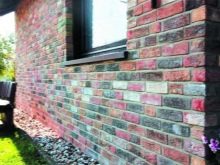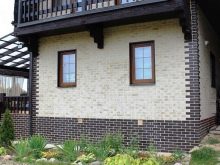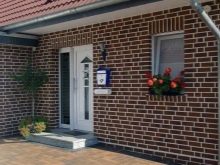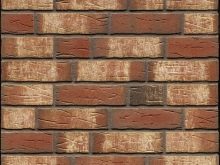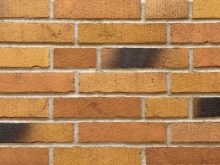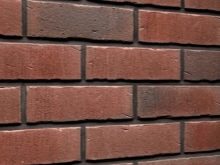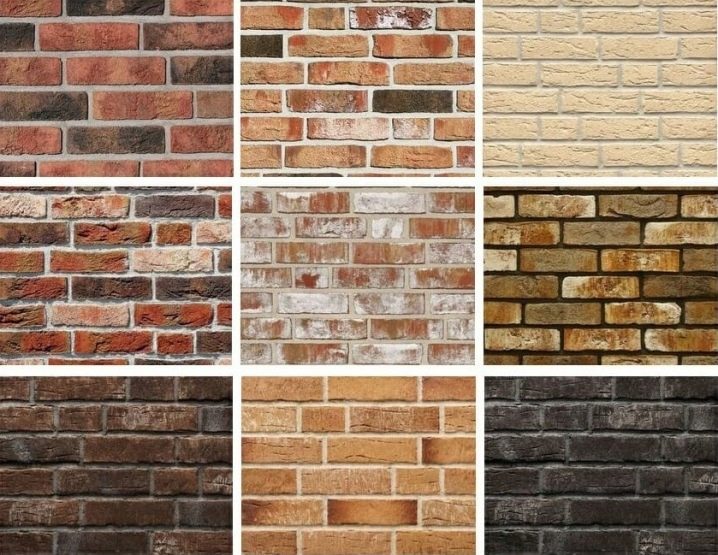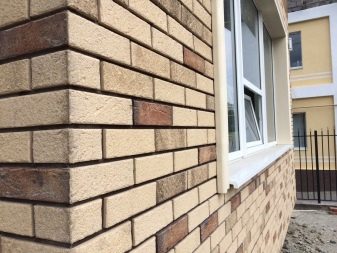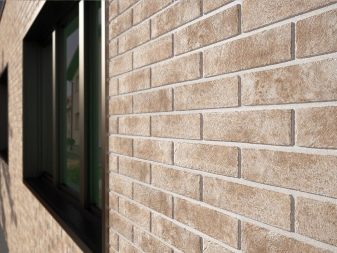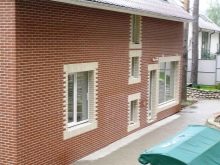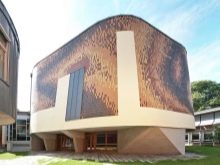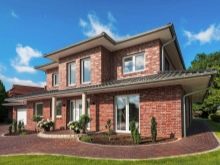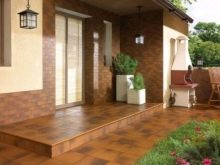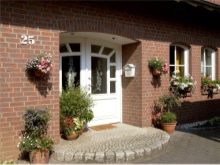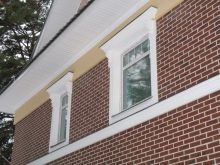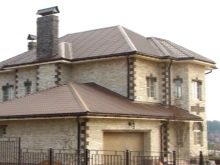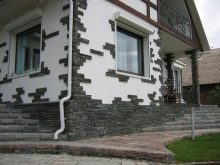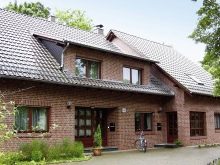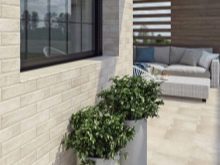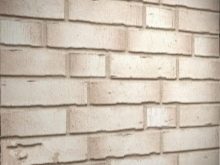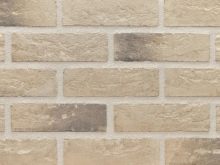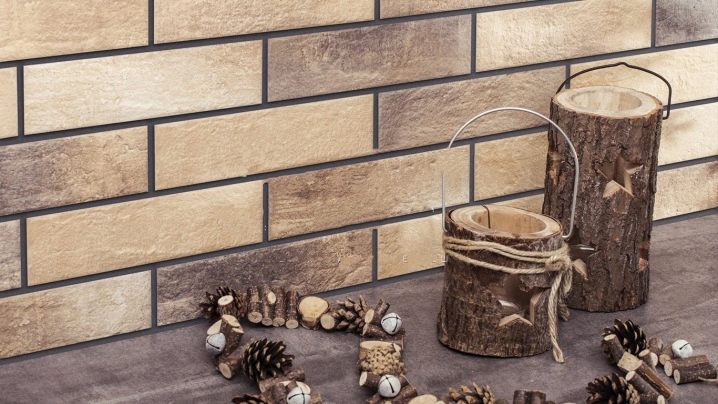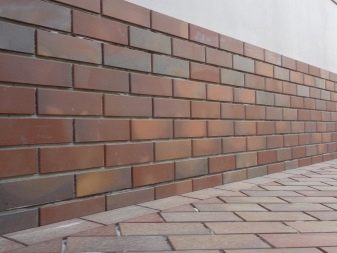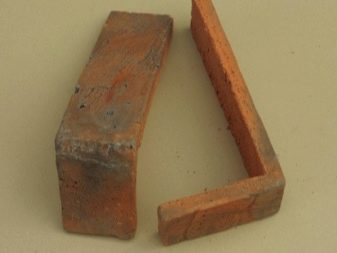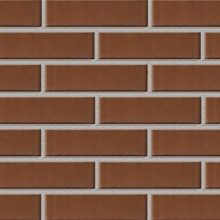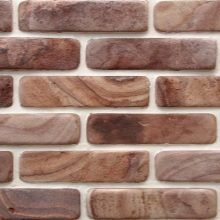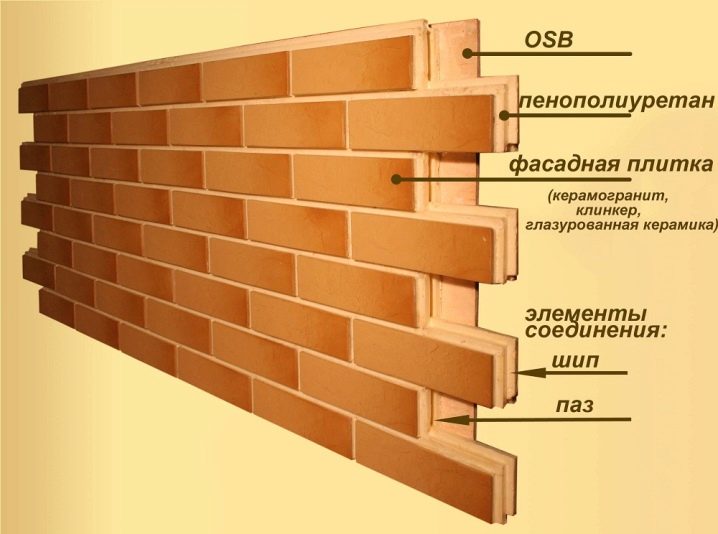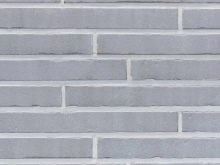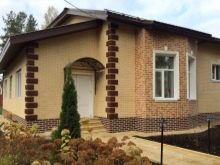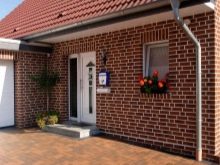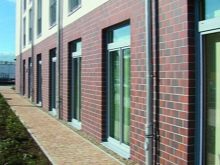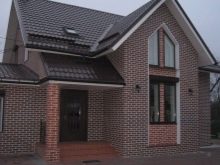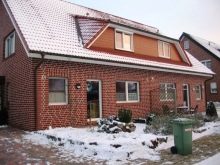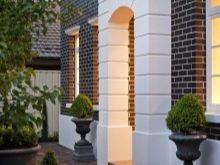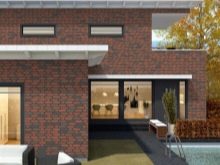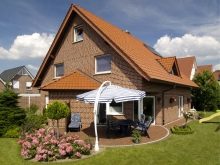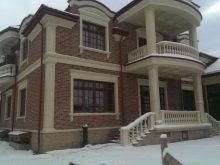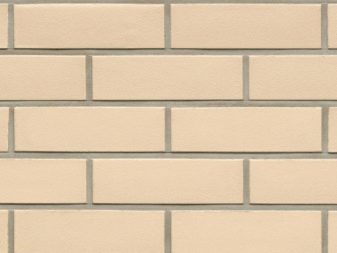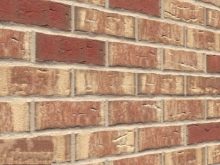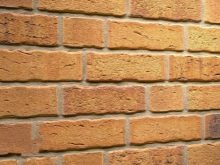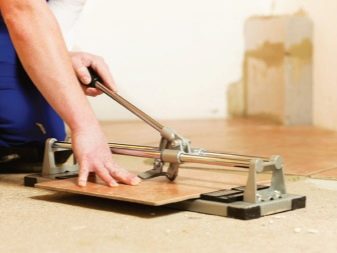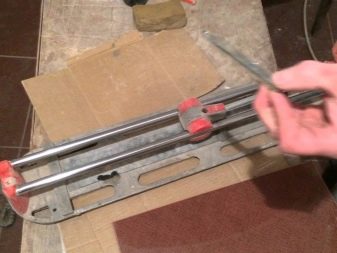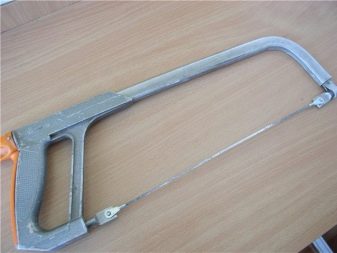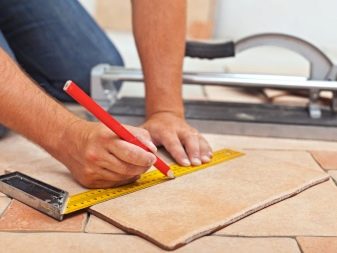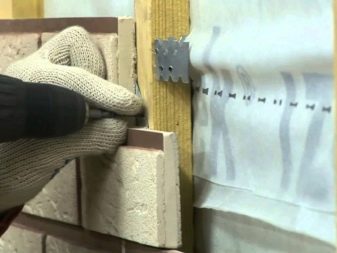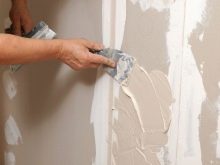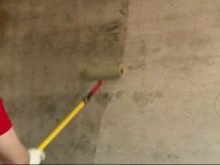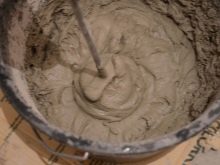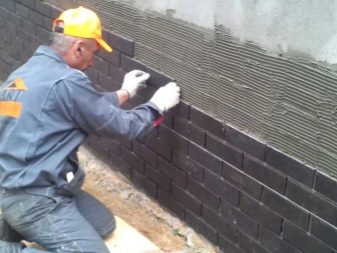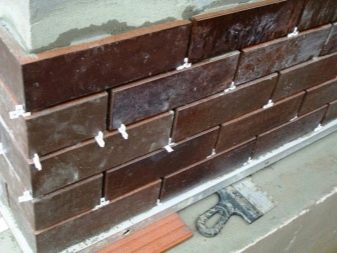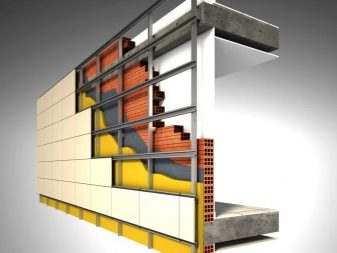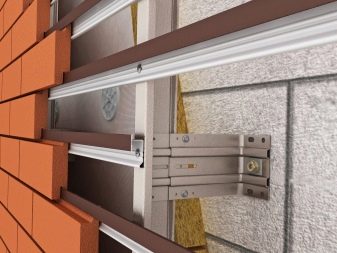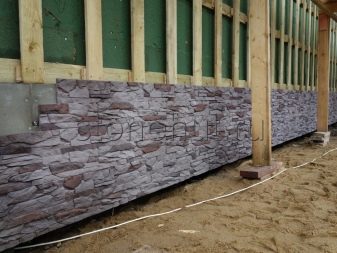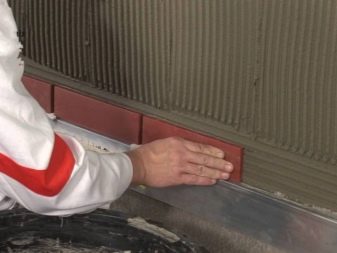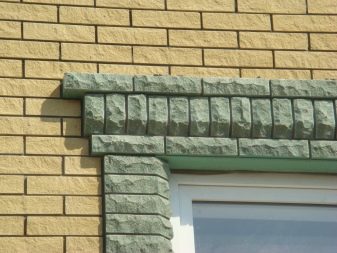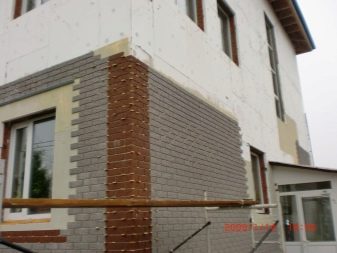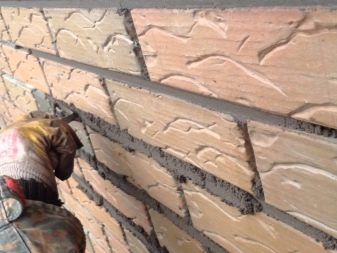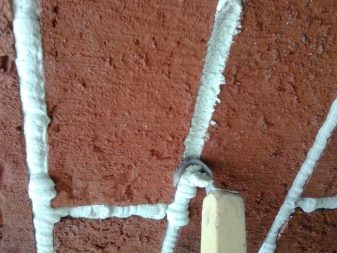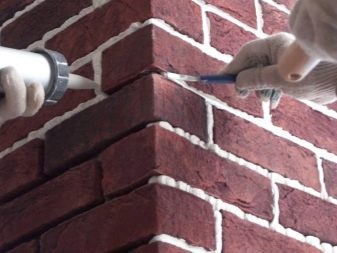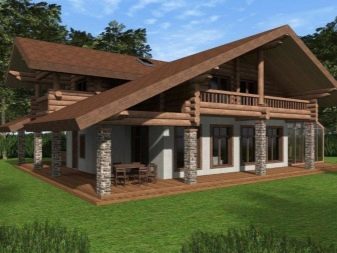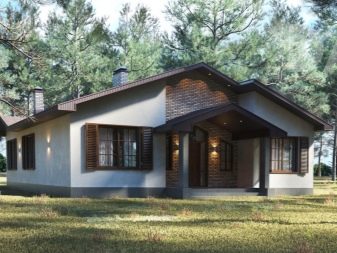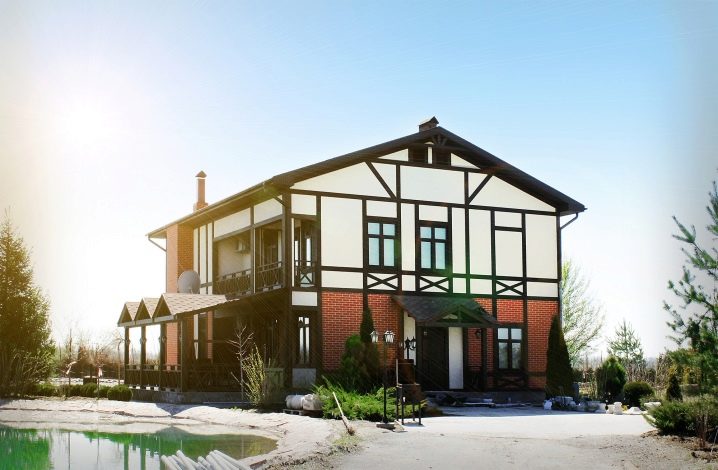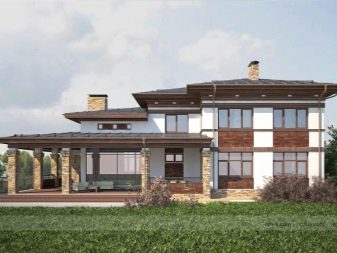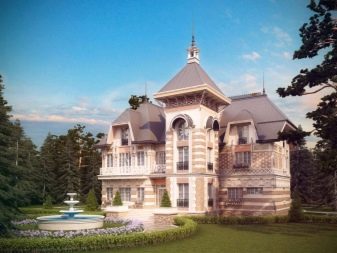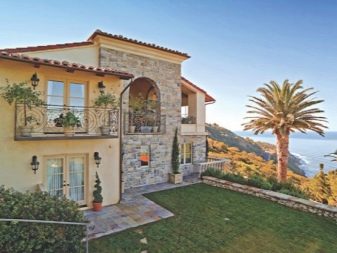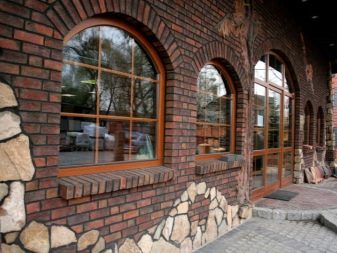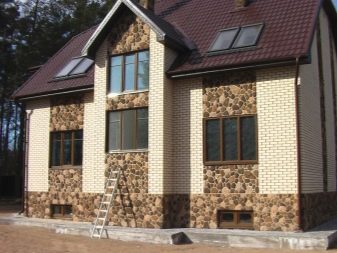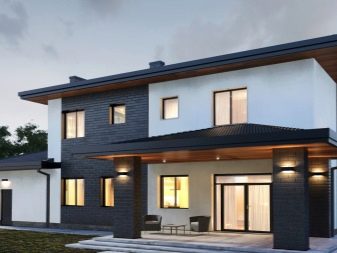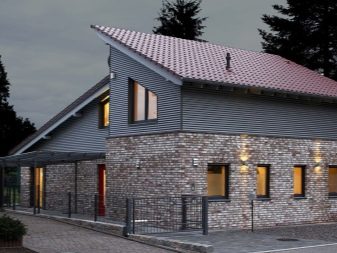Brick tiles for facades: features of the material and subtlety of installation
Facade tiles have been known since the beginning of the 17th century. It appeared as an alternative to clinker facing brick and to this day does not give up its positions, remaining one of the most popular finishing materials.
Specifications
The front brick tile differs in high indicators of durability, has long service life. This is due to the characteristics of the composition and manufacturing technology. Clinker is a mixture of shale clay, solvents of oxide origin, as well as special additives. Next, the raw material is given the desired shape (by extrusion or pressing), after which the future tiles are baked at a temperature of 1300-1400 ° C.
The result is a homogeneous, extremely durable and reliable material, externally similar to stone.In addition, today also produced clinker tiles that mimic brickwork.
Among the technical characteristics of the clinker tiles for the exterior cladding of the facade the most important are several indicators.
- Mechanical strength. The material successfully withstands all types of loads - bending, impact, abrasion and compression. The minimum strength indicators are M400 (i.e., 400 kg of force per 1 sq. Cm.). The maximum is the value of strength equal to M800. For comparison: the strength of a brick for cladding averages M250.
- Frost resistance. The tests carried out make it possible to assert that, without prejudice to its integrity, the material can withstand up to 150 cycles of freezing and defrosting. If you look at old buildings lined with clinker, it becomes clear that in practice this figure is much higher. Increased rates of frost resistance due to low moisture absorption of the material, which on average is 2-4%.
- Density, vapor permeability and thermal conductivity. The product has a sufficiently large density. Average is 1.9-2 kg / sq. dm, which explains his considerable weight.
Clinker cannot boast of low thermal conductivity.on average, it is within 0.95-1.2 W / (mK). That is why it is considered a protective and decorative, rather than heat-insulating coating.
Due to the peculiarities of the production, the surface of the tile is covered with the smallest pores through which moisture does not penetrate, but water vapor is removed. This suggests that the material is vapor-permeable, "breathable."
The form of release of material are tiles with a thickness of 15-25 mm. The dimensions of the parameters are variable. There is a tile imitating a brick and corresponding to its size (250x120 mm). The so-called Old-German tile has parameters of 240x71 mm, and the modern “American” analog is 295x57 mm. More information about the size of the products and their labeling - in the following paragraphs of the article.
The main mass of facade clinker is unglazed, its shade corresponds to the natural colors of clay (yellow-terracotta and brown scales), and there are also light beige, gray, graphite shades. If we are talking about glazed tiles, then the color can be any. However, it is more often used for interior decoration.
Scope of tile is considered facing of facades. In addition, it serves as the basis for the hot-melt (insulated counterpart). High adhesion allows the use of products on concrete, wooden, stone, precast wall panels. The durability of the facade is determined not only by the quality and strength of the tile, but also by the quality of the adhesive composition and inter-smooth grouting.
The technology of the organization of the facade can be dry and wet, ventilated and non-ventilated. More information about the features of each and installation technology - in the relevant section of the article.
Advantages and disadvantages
The material has the following obvious advantages:
- increased strength indicators comparable with similar values of natural stone and porcelain stoneware;
- low weight, which eliminates the additional reinforcement of the foundation and facilitates the process of transportation and installation of tiles;
- low moisture absorption in the range of 1-6%;
- frost resistance due to the presence of pores in the material, through which moisture is removed outside and does not freeze at negative temperatures in the thickness of the tile;
- long period of operation, which is on average 40-50 years;
- weather resistance, including to squally wind, UV rays;
- resistance to temperature changes, preservation of tile geometry;
- resistance to aggressive media, primarily acidic and alkaline, as well as the absence of efflorescence on the tile surface;
- hygiene, biostability - on the surface does not form mold, fungi;
- fire resistance - non-combustible material;
- environmental friendliness of the material;
- uniform pigmentation of tiles, so that even when chips and cracks appear on the surface, they will remain hardly noticeable, and the facade will not lose its presentability;
- high adhesion of the material due to the presence of grooves on the inside of the tile, locking joints;
- unpretentiousness to the base material - the tile can be fixed over concrete, wooden, prefabricated panels, stone walls;
- variety of design options and colors (90 shades);
- ease of installation and ease of maintenance.
As well as any finishing material, the brick tile has shortcomings.
- Enough high cost of products. Although, if you compare its cost with the price of a facing brick, clinker will be more accessible.User feedback suggests that the high price pays off the long-term service life of the material and its reliability.
- The fragility of non-installed plates, which can cause material failure during operation or installation.
- Installation of plates with insulation requires careful calculation of the dew point. The fact is that these panels have a thin polyurethane layer, therefore, it is necessary to calculate the dew point, taking into account the use of other thermal insulation materials.
Kinds
The clinker tile for the facade has different dimensions, and therefore the following types of material are distinguished:
- L-NF (295x71 mm) is the largest tile, for decorating 1 square meter. m requires an average of 40 pieces;
- WDF (215x65 mm), for registration of 1 square. m required 59 tiles;
- WF (21x5 mm) - the smallest possible size, in 1 square. m holds 73 tiles.
Large and medium tiles have a thickness of 15 mm, small - 17 mm.
The specified dimensions and markings are relevant for models of domestic production.
European counterparts have slightly different dimensions. Their characteristic feature is a single length - 240 mm. Accordingly, the purchase focuses only on the width of the tiles.
It may be the following:
- 2DF - 113 mm wide tiles, per 1 sq. M.m required 32 pieces;
- DF - width 52 cm, consumption - 64 pcs / sq. m;
- RF has a width of 65 mm, so for 1 square. m required 54 tiles;
- NF with a width of 71 mm, consumption per 1 square. m - 48 tiles.
The thickness of imported products is 17 mm.
Finally, isolated American facade clinker. Its length is 193 or 295 mm, the width can be 57, 71 or 92 mm. Thickness is the same for all tiles - 15 mm. On 1 square. m consumed 33-74 tiles.
In addition to the facade panels, emit base and corner. The socle tile differs in the bigger thickness, and, so, has the bigger weight and strength indicators. The second ones are designed for a beautiful and hermetic design of corner joints, produced exclusively by extrusion technology.
The basis of extruded corner tiles are ground into flour mineral particles (burnt white and red clay, mica, marble or granite chips) and polymer resins. Due to this, the tile becomes flexible, it can be cut with a sharp mounting knife. At the same time, it is characterized by the same properties as the facade analogue; it also does not look different from it.
In terms of design features, distinguish the following types of material:
- smooth tile brick - the most common and easy to maintain option;
- a material having a relief surface that can imitate not only brickwork, but also the surface under a stone;
- the tile imitating the made old brick with characteristic chips and cracks.
Tiles are usually divided into thermopanels and those that are not supplemented with a layer of insulation. Insulated material allows you to protect the facade and increase its thermal efficiency, to give it an attractive appearance. Structurally, it consists of a clinker tile and a layer of thermal insulation material.
The latter is polystyrene foam, polyurethane foam or mineral wool. The thickness of the layer is 30-100 mm.
Preference should be given to the material with polyurethane foam insulating layer, since it has the lowest thermal conductivity and is characterized by resistance to environmental factors.
The thermoplate can consist of several layers:
- double layer includes insulation and clinker;
- three-layer - “cake” of clinker, an insulator and a substrate of a moisture-resistant OSB - plate, due to which it acquires greater rigidity and strength;
- The four-layer panel in its structure is similar to a three-layer, but is additionally equipped with a refractory substrate.
Despite the high thermal insulation performance of thermopanels, it is not always rational to use them during installation. So, for cladding prefabricated panel and frame houses, where there is already a layer of insulation, it makes no sense to purchase thermal panels. They are also not needed when organizing ventilated facades, as well as for covering garages, arbors, fences.
Finally, today produced corrugated seamless tiles, characterized by a lack of chamfers. This achieves the visual effect of a single monolithic structure of the facade without seams. The plates still do not fit abutly, a small gap between the elements remains. It is required for thermal expansion of the material.
Tips for choosing
- Choosing the thickness of the material, consider the climatic conditions of operation. The more severe they are, the greater the thickness should be tiles. For facing buildings located near water bodies, thick tiles are also selected.
- Immediately consider whether you are ready to devote time to care for the material. The easiest to use is a smooth stone under the brick. Dust and pollution accumulate in the grooves of the relief analogs.
- The production of clinker is conducted from natural ingredients, the stocks of which are limited. The production process is energy intensive, the appearance of marriage with the slightest inaccuracies of technology. All this leads to the high cost of the finished product, which, on average, starts at 4,000 rubles.
- Focus on this figure when buying, do not be tempted to buy cheaper material. Otherwise, the probability of acquiring a fake of doubtful quality is high.
- If possible, preference should be given to products of famous European brands. As for Russian-made products, they can not always boast of quality that meets European standards. In addition, the design of imported tiles is usually more interesting, and the choice is more varied.
- Together with the tile it is rational to immediately purchase glue and a trowel compound. These should be cold-resistant mixtures that can withstand at least 50 freezing cycles. The grouting material is usually matched to the color of the tile. This is necessary so that the possible deformation of the tile due to temperature changes is invisible.
- Glue should differ not only frost resistance, but also be characterized by elasticity and high values of adhesion.
- Calculate the required amount of material can be measured by the area of the facade and taking away from the result the area of the door and window openings. Next, you need to find out how many tiles of the chosen size are required per 1 square meter. m (do it yourself or find similar information on the packaging of the tile). The resulting result remains to be multiplied by the number of square meters of the facade to be finished. As a result, you will receive a figure corresponding to the required number of panels. Do not forget to add another 7-10% to the stock.
- Experts recommend before laying open all packages with clinker and mix tiles. This will avoid the effect of the striped decoration of a private house, since tiles of even one batch may have slight differences in color. This recommendation becomes a mandatory rule if tiles of different lots are purchased. The only exception is the deliberate use of assorted products to achieve a particular aesthetic effect.
- Hinged facade involves the purchase of profiles and fasteners, make sure that they are made of anti-corrosion materials or have a similar coating.
- If you decide to purchase thermopanels, it is important to know that this material has low rates of flexibility. This means that it can only be mounted on level ground. As already mentioned, the best insulation for this material is polyurethane foam.
- Plates with polystyrene heat insulator will last less, due to their shrinkage. The material with mineral wool needs careful waterproofing, which increases the complexity and cost of installation. In order for the tile to provide high-quality thermal insulation, the thickness of the insulation must be at least 60 mm.
- Going to the store, decide on the color and design of the tile, it will greatly simplify and speed up the process.
Universal can be called smooth, with brick tiles of light beige shades.
These can be found in the Perla liso collection of the German brand Feldhaus Klinker, for example. The tiles are medium in size. And the model of the 722 Paglio series from the German manufacturer Stroeher is almost the same in color and texture, but large format.
Original samples for different types of stone are presented in the collections of the brands Feldhaus Klinker, Stroeher, Cerrad (Poland). High-quality tiles for classic burned aged brick are in the Greetsiel Friesisch-bunt genarbt collection of German-made Roben. Leading positions in the production of thermopanels are occupied by Termozit.
Polish tiles are usually cheaper than German.
- When choosing a material, remember that a single tile at a distance of 30-40 cm from the eyes looks different than a fully lined facade from a distance of 3-4 meters. But this is exactly what the overview for passers-by or guests entering the house looks like. Do not forget to not only carefully examine the tile close, but also to evaluate its appearance on the samples in the store (usually good sellers make a small calculation of several tiles), as well as trying to send a beam of a flashlight at it. This will provide a more accurate picture of the appearance of the tile on the facade.
- When choosing 2 different shades for facade and plinth tiles, make sure they are compatible. Not recommended products with overflows. The grout should be one color, its task from an aesthetic point of view is to combine the multi-colored plates into a whole. Highlight brickwork allows grout to a tone darker or lighter than the color of the tile.
- Pay attention to the composition - the basis of the product should be shale clay without hazardous additives. The quality and durability of the color of the tiles depend on the method of staining. The best option - coloring in the firing process without the addition of artificial colors.
Tile cutting rules
Those who decided to do the installation of clinker tiles with their own hands, sooner or later will have to face the need to cut tiles. Both standard and extended American tiles are cut. Since the material is brittle, non-observance of the cutting principles will lead to splitting of the tile. To eliminate such a nuisance will allow the use of special cutting tools.
It is easiest to cut a tile at a right angle using a tile cutter with a diamond disc. This device with water cooling will allow to cut material quickly and without noise. In this case, the cut will be neat and smooth, without chipping. Using an automatic tile cutter is especially convenient if you need to cut a large number of tiles.
However, this unit has a relatively high cost, so for home use it is quite possible to do with a manual counterpart, and sometimes a tile cutter with tongs.Using the latter, install the tool in such a way that the cutting line falls in the middle of the tongs. During the work it is necessary to exclude sharp, jerky movements.
Finally, a straight cut can be done with a grinder. True, the result will be less accurate than using a tile cutter. In addition, the process is accompanied by strong noise and the formation of large amounts of dust.
For curly cutting material used a hacksaw with a diamond string.
However, its use may be beyond the power of an inexperienced master. In this case, it is better to use clippers. The cut will be rough, with notches, so it is polished using fine sandpaper. If necessary, cut into the material ideal circles apply a hole saw.
It is important to carefully measure the tile and pre-plot the cut line. Otherwise, you can get trimming inappropriate sizes. When cutting the tile should lie on a flat surface. One hand should hold the material, ensuring its fixed position, the second hand - to direct the tool without pressing it.Work should be carried out in protective glasses and a respirator.
Facing stages
Depending on the material used, the initial state of the working surfaces and the desired result, wet or dry installation can be used. In the first case, the facing tile is mounted directly on the prepared wall. For this type of installation, a perfectly smooth and smooth wall is a prerequisite; with a wet type of installation, the load on the foundation of the building increases.
The dry method involves the installation of crates on which the tile is fixed with screws. However, it can also be glued to the subsystem.
Using clinker tiles, ventilated and non-ventilated facades can be organized. In the first case, an air gap remains between the facing and the wall. Such a system does not increase the load on the walls, allows you to hide tangible defects in its surface and improve the thermal efficiency of the building. Thermal insulating materials are sometimes placed in the resulting air gap.
Wet installation of the material is carried out in several stages.
- Preparation of the base. The working base must be leveled (allowable height difference - no more than 2 mm per square.m), if necessary, strengthen. After this, the base is puttied and primed with the use of deep penetration compositions (usually primers). Further, the surface dries naturally, to mount the plates on a wet basis, as well as to work in bad weather is unacceptable.
Smooth surfaces, such as reinforced concrete walls, need to be roughened to improve adhesion.
To this end, the surface is covered with notches, after which it is primed in 2-3 layers.
- Marking the wall. Starting from the top of the window slopes, you should draw horizontal stripes on the surface to further install rows of slabs. At the same time, 5-8 mm recede from the upper slope, this is the distance for its decorative design.
- Glue preparation. It is important that the adhesive solution is suitable for outdoor installation, was intended specifically for the clinker tiles. When mixing the composition, it is necessary to strictly follow the instructions; it is more convenient to knead the composition at low speed using a mixer mixer.
- Applying glue. Most of the glue is applied to the wall, a little less of it - on the back side of the tile. For work use a notched trowel. The thickness of the adhesive layer is 10-14 mm.
The glue dries quickly, so it is irrational to immediately apply it to the entire wall. A sufficient area of application is a little more than the applied tile, that is, after the tile is installed, a small amount of glue should remain around it on the wall.
- Gluing tiles. Laying clinker tiles starts from the corner of the building, below. First of all, the corner tile is fixed, the first row starts from it. Each element with glue applied to the back side is applied to the wall and pressed for a few seconds with a mallet. In this case, the excess glue protruding into the interstitial space is removed. The inter-tile gap is equal to 10-14 mm, to observe its uniformity allows the installation between the rod plates with a round cross-section and a diameter of 6-8 mm or mounting crosses.
The choice of the master - 2 types of styling. In the first case, the rows of tiles are stacked over the entire surface of the facade. In the second - the tiles are mounted in small sections of 3-4 rows.
When using thermopanels installation technology looks different.
- Surface preparation is no different from that described above. If the surface of the walls is extremely difficult to align, you can build a metal or wooden frame on which the tile will be mounted.
- An aluminum profile is installed at the bottom of the wall (lathing), which will serve as a starting bar.
- A similar strap is fixed at the highest point of the wall, providing for lining.
- Installation also begins with corner panels, from left to right. The first panel is inserted into the profile, it is fastened with screws or screws.
- The next panel is also inserted into the bar, the spikes of the elements are treated with sealant or foam.
Unlike laying conventional clinker tiles, thermopanels can be mounted in only one way. You can proceed to the installation of the next row only after the installation of the previous one has been completed. Experts recommend further processing the seams with sealants to prevent the insulation from getting wet during operation.
The organization of a ventilated facade system begins with the preparation of the base.Primer formulations with antiseptic effect. Then on a dry surface of the wall it is necessary to fix the waterproofing vapor-permeable membrane. Over it the framework from metal profiles is mounted.
In the space between the frame profiles fit insulation. This is usually basalt or mineral wool in formations 50-150 mm thick (the choice of thickness depends on climatic conditions).
A windproof membrane is mounted over the heat-insulating material with overlapping, which should also be characterized by vapor permeability. Further, the insulation and the membrane are fixed with each other and the facade with the help of dowels of the disc type. 2-3 mounting points on a sheet of insulation will be enough, it is important to place one of them in the center.
After that you can start laying clinker. The distance between it and the insulation should be at least 25 mm.
There are 2 ways to fasten the material.
- Horizontal rails are mounted on the vertical guides, the width of which is 20-30 cm. The lath spacing is 40-50 cm. After that, plywood sheets or OSB sheets are attached to the rails across the entire area of the facade. The tile is fixed to the surface obtained with a wet method. For better adhesion, plywood and OSB sheets are pre-ground.
- To perform the installation of this technology applies a special tile with grooves and ridges.To it is necessary to pick up special profiles on the frame, also equipped with a locking mechanism.
These profiles are mounted on the crate, the step width corresponds to the width of the tiles used. After that the tile is fixed - its lower ridge is combined with the upper profile groove. The profile comb, in turn, is inserted into the groove of the upper part of the clinker.
Laying tiles, regardless of its type, is carried out in the warm season, in dry weather at a temperature of + 5- + 30 ° C.
Making door and window openings
When finishing slopes, it is not necessary to achieve a perfectly flat surface, and the use of special corner elements eliminates the need to dock tiles in the corners.
Improving the adhesion of slopes will help the notching. Obligatory stage of work is the application of a primer on the surface. For slopes, you can use tiles of reduced size. But it is rarely possible to find such, often have to cut the standard material.
Laying should begin with fixing the corner element, from it across the entire surface of the slope a row of tiles is laid. If necessary, the tiles are trimmed.If the width of the slope exceeds the width of the tile, then the solid tile is laid at the edge of the slope, and the remaining space (closer to the wall) is formed in “pieces” of the required size.
When facing the upper plane of the slopes, use wooden supports, which will prevent the tiles from peeling off under their own weight. Put the struts and leave them until the glue is completely dry, then remove.
Before cutting and sticking tiles, it is recommended to perform a dry calculation. This will help you find the best styling option. Installation is also carried out with preservation of gaps of 10-14 mm. After the glue dries, you can start grouting.
Seam processing
Grouting is the finishing stage of the lining.
To do this, use one of three types of grouting compositions.
- Mix for moist application. It is used in conjunction with a material that imitates rough stone or aged brick. It is a powder that is diluted with water to the consistency of loose earth. Next, this mixture with a spatula filled seams. This is quite a laborious process, which is associated with the characteristics of the consistency.
- Grouting with plasticizers. It is also a dry mixture to which water is added. The result should be a consistency resembling sour cream. The composition is applied using a special gun, which is quite simple and convenient. After drying, its excess, protruding beyond the tile, cut off with a knife. The disadvantage of these mixtures can only be called a high cost.
- The composition applied to the entire surface of the wall. Suitable only for smooth clinker bricks. Its distinctive feature is the need to apply not only in the intersectional gaps, but also on the surface of the tiles. Speakers excess grout is also removed with a knife after drying.
If the composition of white color is used for jointing seams, refrain from applying the grout with a metal spatula. Oxidized, it can leave dark spots on the grout surface. Instead, choose a silicone or wooden spatula.
Beautiful examples
The use of tiles under a brick or stone allows you to improve the appearance of any structure and give it the sophistication and nobility of an English cottage of the XIX century.
Undoubtedly, cladding the entire facade with clinker material of different shades and sizes is the best solution if you want to turn a country house into a Gothic castle.
Clinker is harmoniously combined with other finishing materials. One of the most popular "companions" of tiles is wood. When using natural wood will be able to create a completely eco-friendly housing.
See how the combination of clinker tiles under the chopped stone with wooden surfaces in this project of the alpine house looks organic. Despite the rather powerful texture of the “stone”, the structure does not look heavy.
The combination of stone and wood is also characteristic of the half-timbered style, a distinctive feature of which is the presence in the decoration of the facades of unmasked wooden beams and supporting structures. The gaps between them are closed with clinker tiles.
For a house in American style (elongated in width with longitudinal interfloor segments), the combination of brick and plastered textures is typical. Combine them allows the use of columns.
The lower part of the building (together with the first floor) is finished with clinker for brickwork, which adds volume and expressiveness to the facade, the upper one is plastered (less often, it is finished with wood).
Regardless of style, the clinker tiles are well suited for plastered facades.Often they look flat and monotonous, but it is enough to arrange the window opening zone, the socle and several zones in the corners of the building with clinker tiles under the brick, so that the house “comes alive” and begins to stand out.
An example would be this Provence-style country house. The main part of the facade is covered with plaster, individual elements are highlighted by brick tiles. A large arched window and windows with frequent bindings, stucco elements and balconies with wrought iron parapets made it possible to accurately convey the grace and elegant simplicity of the style.
The combination of clinker and stone looks surprising and noble. However, these surfaces are self-sufficient, so it is important to adhere to rule 70/30. Brick clinker should be the basis, the background for stone elements. Moreover, this background (70% of the facade) should not be of different colors, too bright, textured, with modulations.
It is unfair to assume that clinker is only suitable for cladding facades of buildings of classical style. No less impressive, it looks in modern exteriors. Here there is a combination of brick texture tiles with concrete, plastered and wooden surfaces.Columns and part of the facade, decorated with dark tiles with imitation bricks, give the building expressiveness.
The following video is about the properties of the clinker tile.

